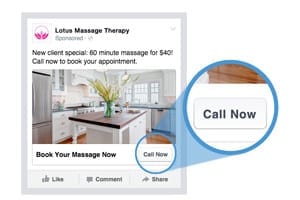Phone calls are far from an analog experience — they’re a key part of the new omnichannel path to purchase.
 It’s easy to forget that smartphones, with all of their capabilities and options, are fundamentally communication tools. Yes, the iPhone 7 is basically a mini computer, but at its core it’s still a phone that connects people on a very human level.
It’s easy to forget that smartphones, with all of their capabilities and options, are fundamentally communication tools. Yes, the iPhone 7 is basically a mini computer, but at its core it’s still a phone that connects people on a very human level.
Despite (or rather, because of) digital adoption and mobile innovation, inbound phone calls to businesses increase every year by the billions. Google, Amazon and Facebook continue to invest in features that make it easier for consumers to call businesses. BIA/Kelsey estimates that mobile search will drive 169 billion calls to businesses in 2020, up more than 120% from 2014. According to Google, 70% of consumers have placed a call directly from a mobile search ad. All of this adds up to a huge opportunity for marketers, especially because inbound calls convert at a rate 10 to 15 times higher than leads from digital channels.
Digital Marketing Drives Phone Calls
The idea that digital adoption leads to omnichannel engagement may be counterintuitive, but the evidence is widespread. As mobile search has overtaken desktop search, we’re seeing that phone calls to businesses are on the rise across industries. Our research validates this. Invoca’s Call Intelligence Index analyzed over 58 million calls to businesses through our platform and found that digital marketing continues to drive phone calls at an upward clip:
- In 2015, digital channels drove 92% of calls to businesses, up from 84% in 2014
- Mobile search is the number one call driver, accounting for nearly half of calls to businesses
- 65% of consumers prefer to connect with a business by phone, compared with just 24% who prefer to fill out an online form
- The average call to a business lasts 4 minutes, 52 seconds, an indication these are high quality phone calls that are likely turning prospects into customers
Smartphones bridge the digital and offline worlds, allowing consumers to jump between searching and calling. We’re seeing that people use their phones to look up information, then call to learn more about a product, schedule an appointment, or make a purchase.
You can make sure phone calls are a part of the customer journey by including phone numbers in your digital marketing assets and mobile search ads. By analyzing the keywords and campaigns that most often lead to calls and conversions, you gain insight to hone your paid search strategy and optimize for these high value interactions.
Google and Facebook Are Accelerating this Change
The connection between searching and calling becomes even more seamless as Google and Facebook continue to invest in phone calls. Ad platforms have a vested interest in helping companies realize returns, and they’re making it easier for consumers to call directly from search or brand pages.
Businesses have a lot to gain by making it easy to reach them over them the phone. Forrester predicts that incorporating click-to-call buttons in advertising can increase purchases by 10%. Companies can make the most of this opportunity by ensuring callers are routed to the right sales or service rep and that the person who answers has the contextual information to have insightful, productive conversations.
The advertising giants have realized that search results on mobile should be paired with the option to call. They’re creating CTA buttons that go beyond “learn more” or “buy” to “call now.”
As a result, consumers are calling businesses at even higher rates. Take a look at the impact Google’s new ad format had on the automotive industry. In 2015, Google introduced search ads for automotive manufacturers. This new format not only displays a carousel of detailed images of the car but also features the location, directions, and a click-to-call button of nearby dealerships at the top of mobile search results. According to data from the Call Intelligence Index, calls to auto companies driven by digital channels jumped by 400% in 2015, the year Google introduced the new format.
It’s no surprise that the auto industry is a good case study for the rise of calls to businesses. Cars are a big purchase for most people, given the high price point and complex options. Consumers want to connect with a human before making a decision, even when they’ve researched them online first.
Customers usually call at crucial times in their path to purchase — for instance, when they’re choosing between two different options. By synthesizing the data from online and offline channels — gaining insight into who’s calling based on age, location, income, pages of the website they’ve visited and products they own — you can ensure that those calls are as helpful as possible and more likely to result in a sale.
Encouraging prospects to speak with a live representative sends a strong signal that they can trust the company. Make sure your click-to-call phone numbers are prominently displayed on all your digital assets, including ads, emails, landing pages, and in social. Reinforce the message by encouraging prospects to call with a clear call-to-action.
Connecting the Dots Between Online and Offline
The data supports what marketers know to be true: consumers are switching between search, social, email, web pages, and phone calls when engaging with brands. comScore found that 63% of people complete a purchase offline after searching online. Each customer interaction, whether it happens online or off, must be a seamless interaction with your brand. If you have insight that a given customer prefers to call, since this is how they’ve chosen to contact you in the past, the CTA should be a click-to-call button, not an online form. In this way, you can build an effective omnichannel customer experience.
Facebook has recognized this need to bridge the attribution gap between online and offline channels. The company recently introduced Facebook for Offline conversions, which helps marketers attribute offline sales that were influenced by a Facebook ad. For example, if a consumer views an ad for a cruise in their newsfeed, then picks up the phone to book the trip, the cruise line can attribute the sale to the Facebook campaign that drove that call. This attribution is increasingly important as the lines between online and offline channels continue to blur.
As technology like this becomes the norm, customer expectations will similarly evolve. It’s already off-putting when a business serves you a digital ad for a product you’ve already purchased offline. Incorporating offline data into your online marketing campaigns will help you create a more seamless and personalized omnichannel experience for your customers.
Kyle Christensen is senior vice president, marketing for Invoca.
 Network
Network

